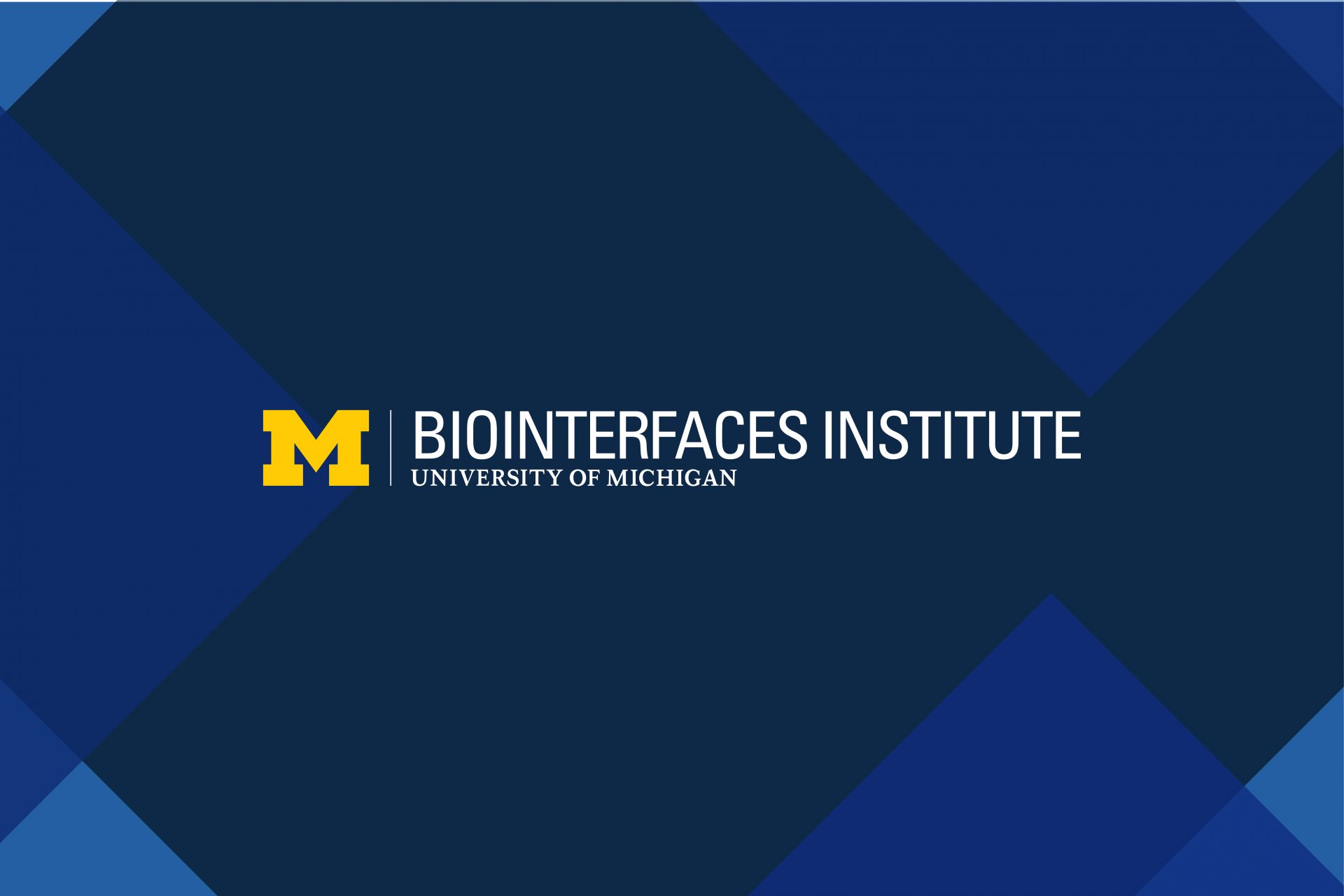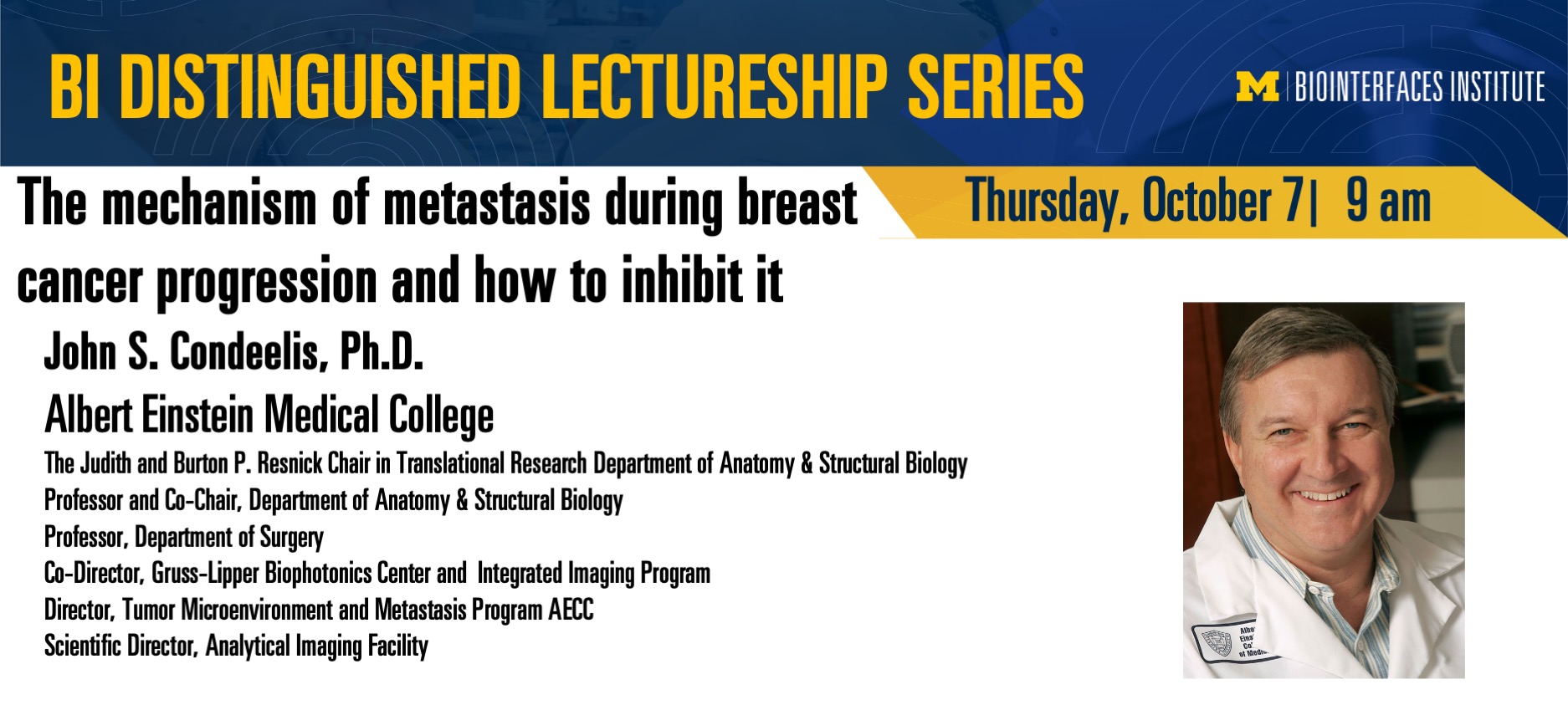
BI Distinguished Lectureship Series with Dr. John S. Condeelis

- This event has passed.
BI Distinguished Lectureship Series with Dr. John S. Condeelis

Abstract
Multiphoton microscopy of live animals in real time led to the discovery of cause and effect relationships between cells leading to metastasis, relationships otherwise not possible to identify using in vitro models. This has revolutionized our understanding of cancer metastasis. Multiphoton imaging demonstrates that tumor cells migrate with macrophages and move with high persistence to blood vessels under the control of HGF gradients (1). At the blood vessel these migrating tumor cells interact with TMEM, the intravasation doorway, composed of a stable three cell complex involving the direct contact between a Mena-Hi tumor cell, endothelial cell and Tie2-Hi/VEGF-Hi macrophage. The TMEM structure itself, as well as the gene expression pattern of tumor cells interacting with TMEM, have been validated as prognostic markers for predicting metastasis in breast cancer patients (2, 3). These were the first markers of metastasis in clinical use derived from multiphoton intravital imaging.
TMEM doorways are the only sites in breast tumors where transendothelial migration of tumor cells and intravasation occur (4). TMEM doorways are found in both primary and metastatic tumor sites in breast cancer (5) and in primary and metastatic sites of pancreatic ductal adenocarcinoma. Clinical trials of TMEM inhibitors targeting TMEM doorways in both primary and secondary sites (6, 7), are now underway in breast cancer patients (clinical trials study number NCT02824575). As tumor cells interact with TMEM doorways, tumor cell crowding occurs around TMEM doorways causing MenaINV expression in cancer cells in response to macrophage-induced NOTCH signaling (8), and other macrophage-dependent tumor cell programming associated with Cancer Stem Cells (CSCs), metastatic seeding and dormancy (9, 10). MenaINV expression is necessary for transendothelial migration tumor cells during intravasation at TMEM doorways (11) and assures the efficient dissemination of seeding competent CSCs and hard to detect dormant tumor cells which, after a delay, contribute to metastatic growth.
Bio
John Condeelis’ research interests are in optical physics, cell biology and biophysics, cancer biology and mouse models of cancer. He and his collaborators developed the multiphoton imaging technology and animal models used to identify invasion and intravasation micro-environments in mammary tumors. Integration of intravital multiphoton imaging with computational /systems analysis of living breast tumors identified the dominant tumor cell phenotypes contributing to invasion and dissemination during metastasis. This led to the discovery and verification of the paracrine interaction between tumor cells and macrophages in vivo, the role of macrophages in the migration of tumor cells during HGF-dependent tumor cell streaming to blood vessels and the mechanism of tumor cell dissemination from primary tumors via TMEM (Tumor MicroEnvironment of Metastasis) to distant metastatic sites. Based on these results, cell collection techniques, including the in vivo invasion assay were developed for the collection of migrating and disseminating macrophages and tumor cells. This led to the discovery of the mouse and human invasion signatures, and the TMEM, MenaCalc and MenaINV markers for assessing risk of metastasis and prediction of response in breast cancer patients to both chemotherapy, and receptor tyrosine kinase and tyrosine kinase inhibitors used to suppress metastasis.
- Leung E, Xue A, Wang Y, Rougerie P, Sharma VP, Eddy R, Cox D, Condeelis J. (2017). Blood vessel endothelium-directed tumor cell streaming in breast tumors requires the HGF/C-Met signaling pathway. Oncogene. 36(19):2680-92. PMID: 27893712 / PMCID: PMCPMC5426963.
- Karagiannis GS, Goswami S, Jones JG, Oktay MH, Condeelis JS. (2016). Signatures of breast cancer metastasis at a glance. Journal of Cell Science. 129(9):1751-8. PMID: 27084578 / PMCID: PMC4893654.
- Sparano JA, Gray R, Oktay MH, Entenberg D, Rohan T, Xue X, Donovan M, Peterson M, Shuber A, Hamilton DA, D’Alfonso T, Goldstein LJ, Gertler F, Davidson NE, Condeelis J, Jones J. (2017). A metastasis biomarker (MetaSite Breast Score) is associated with distant recurrence in hormone receptor-positive, HER2-negative early-stage breast cancer. NPJ Breast Cancer. 3:42. PMID: 29138761 / PMCID: PMCPMC5678158.
- Harney AS, Arwert EN, Entenberg D, Wang Y, Guo P, Qian BZ, Oktay MH, Pollard JW, Jones JG, Condeelis JS. (2015). Real-Time Imaging Reveals Local, Transient Vascular Permeability, and Tumor Cell Intravasation Stimulated by TIE2hi Macrophage-Derived VEGFA. Cancer Discovery. 5(9):932-43. PMID: 26269515 / PMCID: PMC4560669.
- Entenberg D, Voiculescu S, Guo P, Borriello L, Wang Y, Karagiannis GS, Jones J, Baccay F, Oktay M, Condeelis J. (2018). A permanent window for the murine lung enables high-resolution imaging of cancer metastasis. Nat Methods. 15(1):73-80. PMID: 29176592 / PMCID: PMCPMC5755704.
- Harney AS, Karagiannis GS, Pignatelli J, Smith BD, Kadioglu E, Wise SC, Hood MM, Kaufman MD, Leary CB, Lu WP, Al-Ani G, Chen X, Entenberg D, Oktay MH, Wang Y, Chun L, De Palma M, Jones JG, Flynn DL, Condeelis JS. (2017). The Selective Tie2 Inhibitor Rebastinib Blocks Recruitment and Function of Tie2(Hi) Macrophages in Breast Cancer and Pancreatic Neuroendocrine Tumors. Molecular Cancer Therapeutics. 16(11):2486-501. PMID: 28838996 / PMCID: PMC5669998.
- Karagiannis GS, Pastoriza JM, Wang Y, Harney AS, Entenberg D, Pignatelli J, Sharma VP, Xue EA, Cheng E, D’Alfonso TM, Jones JG, Anampa J, Rohan TE, Sparano JA, Condeelis JS, Oktay MH. (2017). Neoadjuvant chemotherapy induces breast cancer metastasis through a TMEM-mediated mechanism. Science Translational Medicine. 9(397). PMID: 28679654 / PMCID: PMC5592784.
- Pignatelli J, Bravo-Cordero JJ, Roh-Johnson M, Gandhi SJ, Wang Y, Chen X, Eddy RJ, Xue A, Singer RH, Hodgson L, Oktay MH, Condeelis JS. (2016). Macrophage-dependent tumor cell transendothelial migration is mediated by Notch1/MenaINV-initiated invadopodium formation. Sci Rep. 6:37874. PMID: 27901093 / PMCID: PMC5129016
- Linde N, Casanova-Acebes M, Sosa MS, Mortha A, Rahman A, Farias E, Harper K, Tardio E, Reyes Torres I, Jones J, Condeelis J, Merad M, Aguirre-Ghiso JA. (2018). Macrophages orchestrate breast cancer early dissemination and metastasis. Nat Commun. 9(1):21. PMID: 29295986 / PMCID: PMC5750231.
- Sharma VP, Tang B, Wang Y, Karagiannis GS, Xue EA, Entenberg D, Borriello L, Coste A, Duran CL, Eddy RJ, Kim G, Ye X, Jones JG, Grunblatt E, Agi N, Roy S, Bandyopadhyaya G, Adler E, Surve CR, Esposito D, Goswami S, Guo W, Condeelis JS, Wakefield LM, Oktay MH. (2021). Live imaging of breast tumors shows macrophage-dependent induction and TMEM-mediated enrichment of cancer stem cells during metastatic dissemination. bioRxiv 2020.09.18.303388.and Nature Communications, In Press.
- Pignatelli J, Goswami S, Jones JG, Rohan TE, Pieri E, Chen X, Adler E, Cox D, Maleki S, Bresnick A, Gertler FB, Condeelis JS, Oktay MH. (2014). Invasive breast carcinoma cells from patients exhibit MenaINV- and macrophage-dependent transendothelial migration. Science signaling. 7(353):ra112. PMID: 25429076 / PMCID: PMC4266931.